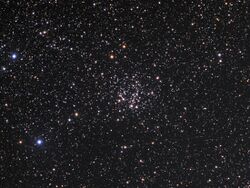Astronomy:NGC 663
| NGC 663 | |
|---|---|
 NGC 663 in Cassiopeia | |
| Observation data (J2000 epoch) | |
| Constellation | Cassiopeia |
| Right ascension | 01h 46.0m |
| Declination | +61° 15′ |
| Distance | 6,850 ly (2,100 pc) |
| Apparent magnitude (V) | 7.1 |
| Apparent dimensions (V) | 16.0′ |
| Physical characteristics | |
| Other designations | Caldwell 10, Cr 20 |
NGC 663 (also known as Caldwell 10) is a young open cluster in the constellation of Cassiopeia. It has an estimated 400 stars and spans about a quarter of a degree across the sky. It can reportedly be detected with the unaided eye, although a telescope is recommended for best viewing. The brightest members of the cluster can be viewed with binoculars. Although the listed visual magnitude is 7.1, several observers have reported higher estimates.[1]
After adjusting for reddening due to interstellar dust, the distance modulus is estimated as 11.6 magnitudes. It is located about 2,100 parsecs distant with an estimated age of 20–25 million years.[2] This means that stars of spectral class B2 or higher (in the sense of higher mass), are reaching the end of their main sequence lifespan.[3] This cluster appears to be located in front of a molecular cloud, although the two are not physically associated. This cloud has the effect of blocking background stars from the visual image of the cluster as it lies at a distance of 300 parsecs.[4]
This cluster is of interest because of the high number of Be stars, with a total of about 24 discovered. These are spectral class B stars that show prominent emission lines of hydrogen in their spectrum. Most of the Be stars in the cluster lie between spectral class B0 and B3.[2] A candidate member of the cluster, LS I +61° 235, is a Be star with an X-ray binary component that has a period of about three years.[5] There are at least five blue stragglers in the cluster. These are stars that formed by the merger of two other stars.[3] Two of the cluster's star systems are likely eclipsing binaries with periods of 0.6 and 1.03 days.[6] NGC 663 also has two red supergiant stars, both located on its periphery[7][8]
The star cluster is assumed to form part of the stellar association Cassiopeia OB8, that is located in the Perseus arm of the Milky Way, along with the open clusters M103, NGC 654, NGC 659, and some supergiant stars scattered between them, all of them having similar ages and distances.[9][10]
Image gallery
References
- ↑ O'Meara, S. J. (2002). The Caldwell objects, Deep-sky companions. Cambridge University Press. pp. 50–51. ISBN 978-0-521-82796-6.
- ↑ 2.0 2.1 Pigulski, A.; Kopacki, G.; Kolaczkowski, Z. (2001). "The young open cluster NGC 663 and its Be stars". Astronomy & Astrophysics 376 (1): 144–153. doi:10.1051/0004-6361:20010974. Bibcode: 2001A&A...376..144P.
- ↑ 3.0 3.1 Marco, A.; Negueruela, I.; Motch, C. (2007). "Blue Stragglers, Be Stars and X-ray Binaries in Open Clusters". ASP Conference Series 361: 388. Bibcode: 2007ASPC..361..388M.
- ↑ Phelps, Randy L.; Janes, Kenneth A. (1993). "Young open clusters as probes of the star-formation process. 2: Mass and luminosity functions of young open clusters". Astronomical Journal 106 (5): 1870–1884. doi:10.1086/116772. Bibcode: 1993AJ....106.1870P.
- ↑ Reig, P.; Fabregat, J.; Coe, M. J.; Roche, P. et al. (1997). "The Be/X-ray binary LS I +61 235/RX J0146.9+6121: physical parameters and V/R variability". Astronomy and Astrophysics 322 (1): 183–192. Bibcode: 1997A&A...322..183R. http://aa.springer.de/papers/7322001/2300183.pdf. Retrieved 2012-04-17.
- ↑ Pietrzynski, G. (1996). "Variable Stars in the Young Open Cluster NGC 663". Acta Astronomica 46: 357–360. Bibcode: 1996AcA....46..357P.
- ↑ Mermilliod, J. C.; Mayor, M.; Udry, S. (2008). "Red giants in open clusters. XIV. Mean radial velocities for 1309 stars and 166 open clusters". Astronomy & Astrophysics 485 (1): 303–314. doi:10.1051/0004-6361:200809664. Bibcode: 2008A&A...485..303M.
- ↑ Pandey, A. K.; Upadhyay, K.; Ogura, K.; Sagar, Ram et al. (2005). "Stellar contents of two young open clusters: NGC 663 and 654". Monthly Notices of the Royal Astronomical Society 358 (4): 1290–1308. doi:10.1111/j.1365-2966.2005.08784.x. Bibcode: 2005MNRAS.358.1290P.
- ↑ Negueruela, I.; González-Fernández, C.; Marco, A.; Clark, J. S. (2011). "A massive association around the obscured open cluster RSGC3". Astronomy & Astrophysics 528: A59. doi:10.1051/0004-6361/201016102. Bibcode: 2011A&A...528A..59N.
- ↑ Humphreys, R. M. (1978). "Studies of luminous stars in nearby galaxies. I. Supergiants and O stars in the Milky Way.". Astrophysical Journal Supplement Series 38: 309–350. doi:10.1086/190559. Bibcode: 1978ApJS...38..309H.
External links
- NGC 663 on WikiSky: DSS2, SDSS, GALEX, IRAS, Hydrogen α, X-Ray, Astrophoto, Sky Map, Articles and images
Coordinates: ![]() 01h 46m 16s, +61° 13′ 06″
01h 46m 16s, +61° 13′ 06″
 |


